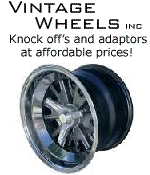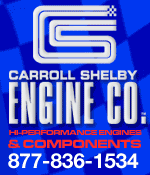If anyone was to tell me that huge gains were possible by changing to a low restriction air filter, I wouldn’t put much faith in it. Basically, if even a poor filter is large enough that the engine is getting all the air it wants, then there’s nothing to be gained. In my case though, my air filters appear to be small and restrictive, so going larger and with freer flowing filter media might just be a wise move.
Below is an advertisement for the filters where it states they were used in original 427 Cobras. Really? But I bought the advertising… and the air cleaners.

Below is a picture of my engine with two 8” Stelling and Helling air cleaners which only have an element 1.5” high.

They come with two filters, a more porous black one and green one similar to what one would find in a Briggs & Stratton lawnmower engine. I decided to clean the green ones and install the black ones to try them out. I noticed that when accelerating as hard as I dared in second gear, it didn’t take as much application of throttle to achieve the same result as when I had the green filters installed.
Below is a picture of a black one as removed… with the further restrictive inner and outer perforated steel bands. The green one has been washed, but still looks dirty.

Back to the K&N filters, I found a comparison of filter flow rate in the chart below:

The Uni-Filter is probably the same as my green filters, although the same source does appear to indicate that the foam filters made by UK companies Pipercross and I.T.G. are better than the Uni-Flow. So K&N sounds like a good choice… if I could get them to fit.
I’m not the first to want to install taller and freer flowing K&N air filters and it didn’t take much research to find a couple of recommended replacements. However I have a hood clearance issue. It’s not really the hood surface, but rather the reinforcing web that runs around the inside perimeter of the hood. The back air filter would have to be moved forward almost ¾” before any increase in height would be possible. This would of course mean the front one also has to be moved.
My manual shows this picture, but I already had things painted and didn't want to cut part of the hood away:

I decided to make offset bases to move the air cleaners forward 7/8”. Any more, and there wouldn’t be enough room to fit the filters around the carb throats. As it was, I had to find an alternate to the recommended replacements as the latter were 1” thick (OD-ID)/2). I managed to find ones only 5/8” thick. I even got them on sale…. Two for less than the regular price of one! (Type: E-1015) This is important to me as I don’t like to spend too much money on an experiment.
Below are the parts I made up. Two everything had to be made. Top left shows the new aluminum base made up from 1/8” plate. It didn’t come out too bad considering I made them with a jigsaw, file and some emery paper. I also made them a bit large so I could trim them better later, plus I wasn’t sure if I would need to provide some sort of lip to keep the filters lined up. A few pins along the inside perimeter of the filter might be an idea, but I'll probably re-work the chrome ones and get them rechromed.

On the right, is the original air cleaner base shown upside down. You can see how it raises the base up to clear various parts of the carburetors. At least 5/16” is needed. Rather than spend time trying to make rings, I simply used some 3/16” fuel line as seen on the left. I joined them using barbed couplers I salvaged from an old Keurig coffee machine.
I also had to make offset rods. I made them out of plated threaded rod but have a piece of SS for later. Good thing as some of the plating burned off. Amazingly the first one came out with exactly the correct offset. The second one was a failure, but my third attempt came out successfully.
Once I finished the installation you can see in the picture below they are much larger. Just scroll back up and take a second look at the normal installation for comparison.

All that’s left was to go test them. If a noticeable improvement is made, then I can see about making things aesthetically better as well as structurally sounder.
I finally got to test the car with roads still damp from overnight rain and it was cold out (low 50s) so traction still wasn’t optimal and I didn’t dare try to push it too hard.
I didn’t expect much as I thought most of the benefits of the new air filters would be higher up in the rpm band. This may be true, but I was surprised at the improvement in the lower rpm range.
First of all, the engine was way more responsive. Instant acceleration. I had a very tiny hesitation before and I had been thinking of experimenting with pump cams, but it’s completely gone now. The engine starts pulling very strong at 2200 rpm where before it was about 2500 rpm. I thought it worked well before, but now it’s incredible.
Thinking about this, I think the reason it’s so much better is that the old restrictive elements acted as a choke and the engine was running too rich.
I am very satisfied and will now put some thought into making nice offset bases that have a lip to help center the filter. I can use my original bases with the spacer section removed and a new carb hole cut 7/8” off center and then rivet on a new base made from a cheap 14” base cut down to fit, centered on the offset and egg shaped to cover part of the original hole in the old base.
Note: I can’t use a single oval air cleaner made for dual quads as my Offenhauser manifold doesn’t have the same center-to-center carb spacing as Ford used. This isn’t so bad as I prefer the look of two separate air cleaners than the Ford oval ones.














 2Likes
2Likes












 Linear Mode
Linear Mode



